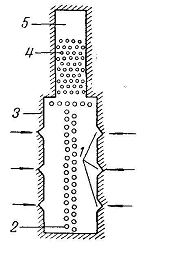
1 – burner,
2 – Pipe Radiation Section,
3 – radiant wall,
4 – convective section,
5 – exit flue gas.
Cold resin enters the bottom part of the radiation coil (2) furnace and moves it upward. At this stage the heating pipes is due to
thermal radiation from the combustion of coke oven gas in a flameless burner (1) located on either side of the coil and the emission of radiation furnace chamber lining
(3). Higher radiation section is a series of tubes protecting the convective section of the direct radiant heat and the final section of the radiation. Higher radiation
section is the convective section (4), which is heated by heat of the combustion products carried away from the radiation section of the chimney (5). Convective
section is necessary to increase the efficiency of the furnace by increasing the completeness of fuel combustion heat.
Advantages of stoves with double-sided heating pipes:
1) uniform thermal load on the entire surface of the pipe (near the stove, with one-sided heating pipes ratio
amount of heat
transferred to the pipe wall, in places of maximum and minimum heat load 1,8:1,
while at the stove with double-sided heating pipes, this ratio
is 1,2:1);
2) a significant increase in the overall coefficient of heat transfer tubes. (a one-sided heated pipe it is 0.88, while
whereas in bilaterally heated tube, this value is increased by approximately 50% and equal to 1.31. This means that for the same amount of heat transferred
surface radiation
pipes at the bilateral heating may be almost 1 / 3 smaller;
3) reduction of pressure loss in pipes by reducing the number of tubes, reducing the temperature of pipe wall,
since this
pressure loss can improve weight velocity heated product;
4) the ability to effectively control the temperature in the coil section of the radiation.
Furnace with two-sided heating pipes with flameless burners are used for medium capacity by about 15 million kcal / h, especially for heating to high temperatures.
They make it possible to precisely control the temperature of the entire length of the tubular coil.
Processed raw material
Coal tar is a mixture of mainly bi-and polycyclic aromatic hydrocarbons and polycyclic systems with hetero
in the rings. The amount of these substances is about 95% of the components of resin. In addition to them in the resin contains 2.1% phenol, 2-3% organic bases,
mostly a series of quinoline and acridine. Coal tar is a unique, unparalleled source of raw materials presently covered
More than 95% of global demand in the condensed aromatic and heterocyclic compounds. The total number of substances in the resin is about 10
thousand, of which identified more than 500 substances. Approximately 50% of the resin is no boiling faction - the pitch, which is a mixture
polycondensed polycyclic aromatic hydrocarbons and by-products of polymerization.
The most important indicators of the quality of the resin from the viewpoint of its processing of components are not soluble in quinoline, moisture content and
ash.
These figures are influenced by:
1) the number of cleaning steps resins;
2) the quality of the pitch as the distillation residue.
Over the past 15 years, noted two major changes in the quality of coal tar. First, the decreased content of components insoluble in quinoline.
This is due to stoppage of old coke batteries with a bad door seal coking chambers. Secondly, the increased content of the resin solids due
use of younger and smaller coal. In addition, new coke batteries are equipped with powerful suction gas to reduce emissions
into the atmosphere, which increases the entrainment of solid particles in the flow of resin. These changes cause difficult for consumers of products of fractionation
coal tar, pitch because they require a high content of components insoluble in quinoline, and low free carbon.
Currently implemented a broad program of research and developed new methods to ensure high bonding properties of pitches for
electrodes.
Production of approximately 350 million tons per year of coke in the world is accompanied by the release of almost 14 million tons of crude coal tar. However, not all resin available for
processing, since some ovens in the U.S. and China has the technology without capture of chemical products, and the resin is burned directly
in the process of coke production.
Coal tar, obtained on the coke batteries with furnaces ka dimensional type used on an industrial scale, mainly on the following three
directions:
- direct combustion in blast furnaces or boilers in power stations;
- partial combustion after treatment in the production of carbon black;
- fractional distillation by various methods, including a high degree of purification.
The use of crude coal tar without processing leads to direct losses of valuable products and adversely affect the ecological situation in
field of application.
It is estimated that each year worldwide is subjected to distillation of about 7 million tons ka mennougolnoy resin. Several compounds found in coal tar in an amount of 1%
or more, then have the resources of each of these substances and may STI its production are significant. Table. 1 shows the contents of the foundations ponents in
coal tar of different plants[5].

The absolute amount of each of these substances are high, the potential to organize their production in pure form. In a large industrial scale in the processing of coal tar get three product groups:
- and their technical mixtures, phenols, bases;
- various industrial oils, lubricants and coatings;
- raw materials for production of carbon materials - coal tar pitch and pitch coke.
The most important features of polycyclic compounds is their thermal stability and oxidation stability, and toxicity for microorganisms. This allows the use of technical mixtures with coal tar processing products for the manufacture of various protective coatings and antiseptic oils that protect the wood.
Great value individual cresols, and mixtures thereof, used for the production of synthetic resins, plasticizers and anti-pyrene for polymeric materials, chemicals for agriculture, various stabilizing additives: antioxidants, polymerization inhibitors, etc.
Currently, small amounts of isolated anthracene - raw material for anthraquinone dyes and diverse based on it. Considered a promising organization registration number of other individual substances, because individual polycyclic aromatic hydrocarbons and heterocyclic compounds are unique chemical raw materials and are valuable for the national economy.
In recent years, the resin isolated pure substances: hinaldin, isoquinoline, which are the initial components for the production of chemical products for agriculture, as well as the indenter used for hydrocarbon resins. These three substances - hinaldin, isoquinoline and indene - currently receiving very high purity and used for the synthesis of drugs.
Range of processed products of coal tar in the enterprises is determined by:
- available equipment for their removal in the final stages of processing;
- markets.
Than the broader set of equipment has a processing plant resin, the greater economic flexibility it has. So, if you decide not to sell all the oil entirely for the production of carbon black or wood preservatives can be isolated in their deep processing of various polycyclic aromatic hydrocarbons, heterocyclic compounds and phenols for sale in different markets. Such commercial flexibility is usually characterized by a powerful processing plant resin, which economically advantageous to provide pure components of resins used as basic raw material for chemical industry.
In recent years, new opportunities for the extraction of various pure substances from the distillate of coal tar, which is associated with the expansion of research in-depth processing of coal tar and the opening of new areas of their application. Therefore, future processing enterprises of coal tar has a sound basis for successful development.
Heat balance
The main part of the furnace thermal calculation is the heat balance, on the basis of which is determined by the need of fuel and general k pdo installed. The overall heat balance of the furnace can be written as[5]

where
QСЖ.Т — heat, separated from fuel combustion, kcal / h;
Qо — heat used in the oven, the heat capacity of the furnace, kcal / h;
Qп — тепловые потери в окружающее пространство,
ккал/ч;
Qд.г —natural heat contained in flue gases, kcal / h;
Qвз —physical heat made ??the air, kcal / h;
Qв.п — physical warmth, made ??by water vapor, kcal / h;
Qц.г — physical warmth, made ??by circulating gases, kcal / h.
All natural heat in the equation is calculated from a temperature of 0 ° C. The equation does not reflect the physical warmth, made fuel, and heat losses due to incomplete combustion, since these quantities are negligible.
The heat used in the oven Qo, is defined as the difference between the heat content of the product at the furnace outlet and will do Research into the furnace and is due process. If heated product flows and chemical reaction, the value of chenie Qo must also include the heat evolved in the re a result of the reaction.
Heat loss to the environment vary in pre affairs QSZH.T 2-10%, the latest types of furnaces, these values ??would be vayut below. Heat loss in the surrounding area depend pend on the temperature in the furnace and its application design and espe cially from the insulating properties of the lining.
Heat carried away by exhaust gases Qd.g depends on their number fraud, composition and temperature. Usually Qd.g values ??are within 15-25% QSZH.T, a large excess air and high temperatures exhaust gases, they can reach 40% QSZH.T If we denote the number of flue gas VGg, their temperature at the outlet of the convection section and their average heat at this temperature, the UK, then

Heat introduced by air Qvz, more noticeably in the heat balance only in those cases where the air, failed to burn fuel, heated to high temperatures.
Heat cast steam let down for the atomization of liquid fuels Who Qv.p (only the physical heat of steam, without the latent heat of vaporization) is relatively small and usually does not exceed exceeds 0,5% Qszh.t.
Heat circulating gas Qts.g takes place only in ovens with circulation of flue gases and is defined as Qts.g.
Efficiency of the furnace is the ratio of heat used in the oven to heat, tabled fuel

Efficiency of kilns, which depends primarily on the temperature of flue gases and excess air varies, usually within 60-85%.
Amount of fuel is determined by the thermal capacity of the furnace, the furnace efficiency and lower heating value of fuel

The surface temperature of pipes
For calculating heat transfer in the radiation section of the furnace is necessary to determine the average surface temperature of pipes. To select the material and wall thickness of pipes in the design of the furnace or to determine the allowable heat load for the furnace is critical maximum surface temperature of pipes.
The surface temperature of pipes, mainly depends on the fact ture of the product in the pipes, the thermal load on the pipe surface and the heat transfer coefficient of the product inside the tubes. Very adverse effect on the temperature of pipe sediment arising in some cases on their inner surface (usually a layer of coke), which may lead to unsafe overheating of tubes. Elevated temperature reduced durability of alloys. With a constant excess of the maximum temperature is almost certain pipes are easily damaged.
The calculation of the average surface temperature of pipes produced based on the average product temperature in the pipes and the average load surface of the pipes

where
tС — average temperature of the product in the pipes, ie, the arithmetic mean of inlet and outlet temperature of the product, °С;
qс — average heat load of the pipe surface, kkal/m2 h, ;
dн, dвн, dо — outer and inner diameter of the pipe, the inner diameter of sediment, m;
а1 — heat transfer coefficient inside the tubes, kkal/m2 • h • ° C;
бн, бо —pipe wall thickness and the thickness of sediment, m;
ло,лт —thermal conductivity of pipe material and sludge, kcal / m-hr-° C.
If heated product in the tubes is a liquid and does not need to take into account the formation of sludge, the average surface temperature of the pipe is at 20-50 ° C above the average temperature of the liquid. If the expected appearance of the sediment (coal), counted in the calculation of sediment thickness of 2 mm.
To calculate the maximum surface temperature of pipes to determine the local heat load of pipes and find the maximum heat flow through the pipe wall. Assuming that the heat flow through the pipe wall does not extend in the direction of the pipe perimeter, the maximum surface temperature is expressed

where
Vmax —maximum surface temperature of pipes,°С;
t'— temperature of the liquid in the pipes °С;
qmax— maximum heat flux through the wall of the pipe, kkal/m2 • h.
The maximum temperature is given by assumption is higher than in reality, especially when ah small value. Accurate analysis of the issue [7], taking into account also the thermal conductivity of the pipe wall on the perimeter, in the case when the precipitate is not formed and the radial temperature drop through the pipe wall is negligible, leads to the equation

Degradation processes occurring in a tube furnace
Scaling (high-temperature oxidation of metal)
Scaling manifests itself in the form of high-temperature oxidation the outer surface of the metal chimneys under the influence of flue gases containing excess air and held at high temperature.
Scaling on the outer surface of the chimneys is an increase of thermal stress in the oven, as well as in violation of the burners. In the case where the burner flame is located near the chimney, on the surface oxide layer is formed with a grid of longitudinal cracks.
Scaling is enhanced in the presence of a gaseous medium korrozionnoagressivnyh to the material tube components. Thus, the scaling is enhanced by burning sulfur fuel and the appearance of the resulting sulfur dioxide in the combustion furnace atmosphere.
The reason for scaling the outside of the chimney (from the combustion chamber) is a violation of normal operating furnace, ie, work with high excess air ratio, with excess fuel, or work at a temperature above the normative value. The most intense scaling is observed when operating the furnace at a temperature higher than allowed by the pipe material for the coil.
Typical examples of damage to the metal chimney as a result of scaling are shown in Figure 2[4].

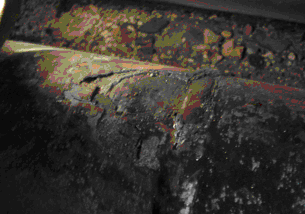

Tarnishing proceeds in several stages:
1) ionization transition metal and its ions in the form of Me (n +) and electrons in the oxide layer;
2) переміщення іонів металу Me (n +) і електронів в шарі оксиду;
3) transport of oxygen from the gas flow to the surface oxide;
4) Adsorption of oxygen from the gas phase on the metal surface;
5) conversion of adsorbed oxygen ions O (2 -) (heat released during adsorption, which causes the dissociation of oxygen molecules to ions);
6) movement of oxygen ions O (2 -) in the oxide layer;
High temperature corrosion of metal
the outer surface of the chimneys
Corrosion resistance of steels in gaseous media at high temperature depends on their composition and gas composition, temperature and duration of exposure, heating and cooling rates, the availability of stress. To a large extent this type of wear prone parts of the central pipe radiant chamber.
Damage to the metal is enhanced in the presence of a gaseous medium korrozionnoagressivnyh respect to the metal pipe components. In the presence of the flue gases of hydrogen sulfide dioxide and sulfur trioxide, water vapor, vanadium oxide (V) and other components, protective film on the heat-resistant steels are destroyed, reducing the durability of the material of the chimneys. The impact of these substances on the material the coil is shown at the metal in excess of 400 ° C, and increases rapidly with increasing temperature[4].
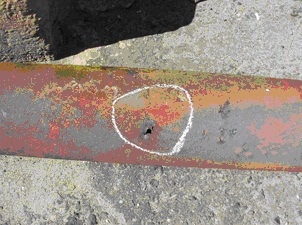
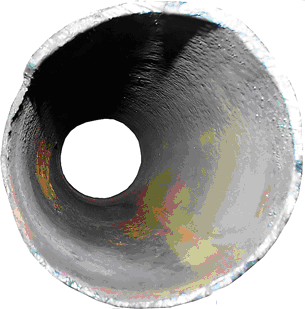
On technological catalytic and thermal cracking, visbreaking, atmospheric vacuum trubchatkah and other installations on the stoves in the pipe coil is coke.
High temperature pipe surface causes thermal expansion of adjacent layers of hydrocarbons. As a result of thermal electric expansion forms a solid porous product - coke is deposited, schiysya on the inner surface of pipes. With increasing temperature, the surface of the pipe coil probability of coke formation increases. On-lozhivshiysya in the chimney a layer of coke is a poor conductor of heat-la, and therefore the coefficient of heat transfer from flue gases to reduce raw material-is. As a result, decreases the amount of heat transferred liquid is reduced heat removal from the metal surface, which leads to overheating of the power-tubes films.
Visible on the image of coke deposits, located on the side pipes, which was turned toward the flame burners[4].
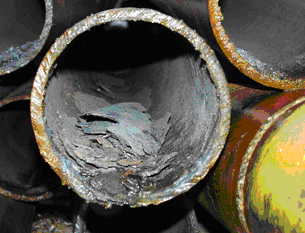
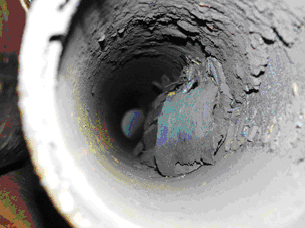
Conclusions
At the time of the site work has not yet been completed, so the results are not given.
References
- Мухин В.Н., Котов Н.В. О допустимой толщине науглероженного слоя на металле печных труб нефтеперерабатывающих установок. // Эксплуатация, модернизация и ремонт оборудования. – 1983. – № 2.
- Конструкционные материалы: Справочник / Б.Н. Арзамасов, В.А. Брострем, Н.А. Буше и др.; Под общ. ред. Б.Н. Арзамасова. – М.: Машиностроение, 1990. – 688 с.
- Воробьева Г.Я. Коррозионная стойкость материалов в агрессивных средах химических производств. 2-е изд. – М.: Химия, 1975. – 816 с.
- http://skymicron.com/index.html – Материаловедение в нефтеперерабатывающей промышленности
- Котишек Я., Род В. Трубчатые печи в химической промышленности. - Л.:Гос НТИ нефтяной и горно-топливной литературы, 1963. - 148с
- Чистяков А.Н., Химия и технология переработки каменноугольных смол: Учебное пособие для вузов. - Челябинск,: Металлургия. Челябинское отделение, 1990. 160с
- Лейбович Р.Е., Яковлева Е.И., Филатов А.Б., Учебник для техникумов. - М., Металлургия, 1982. - 360 с.
About author
